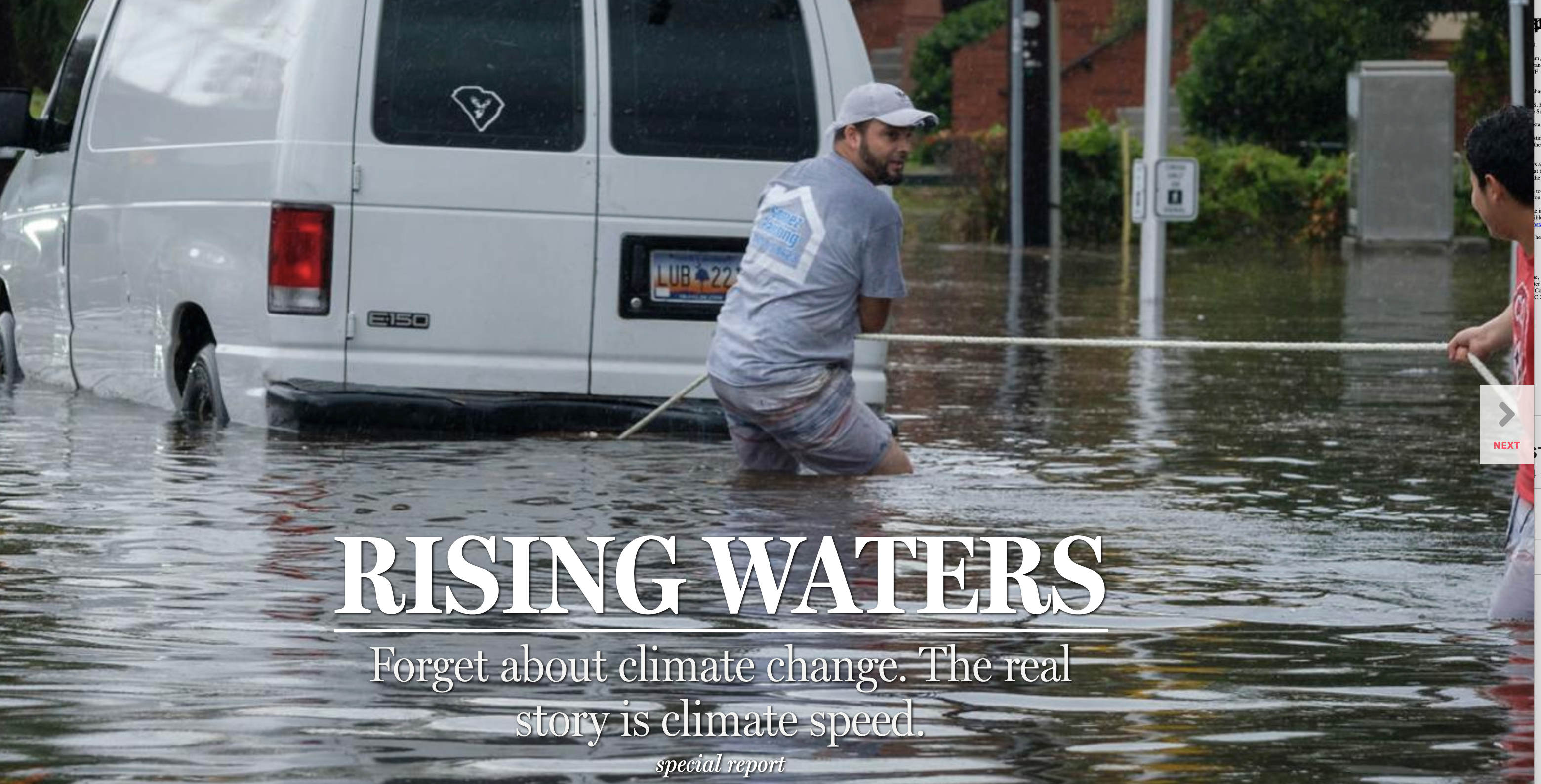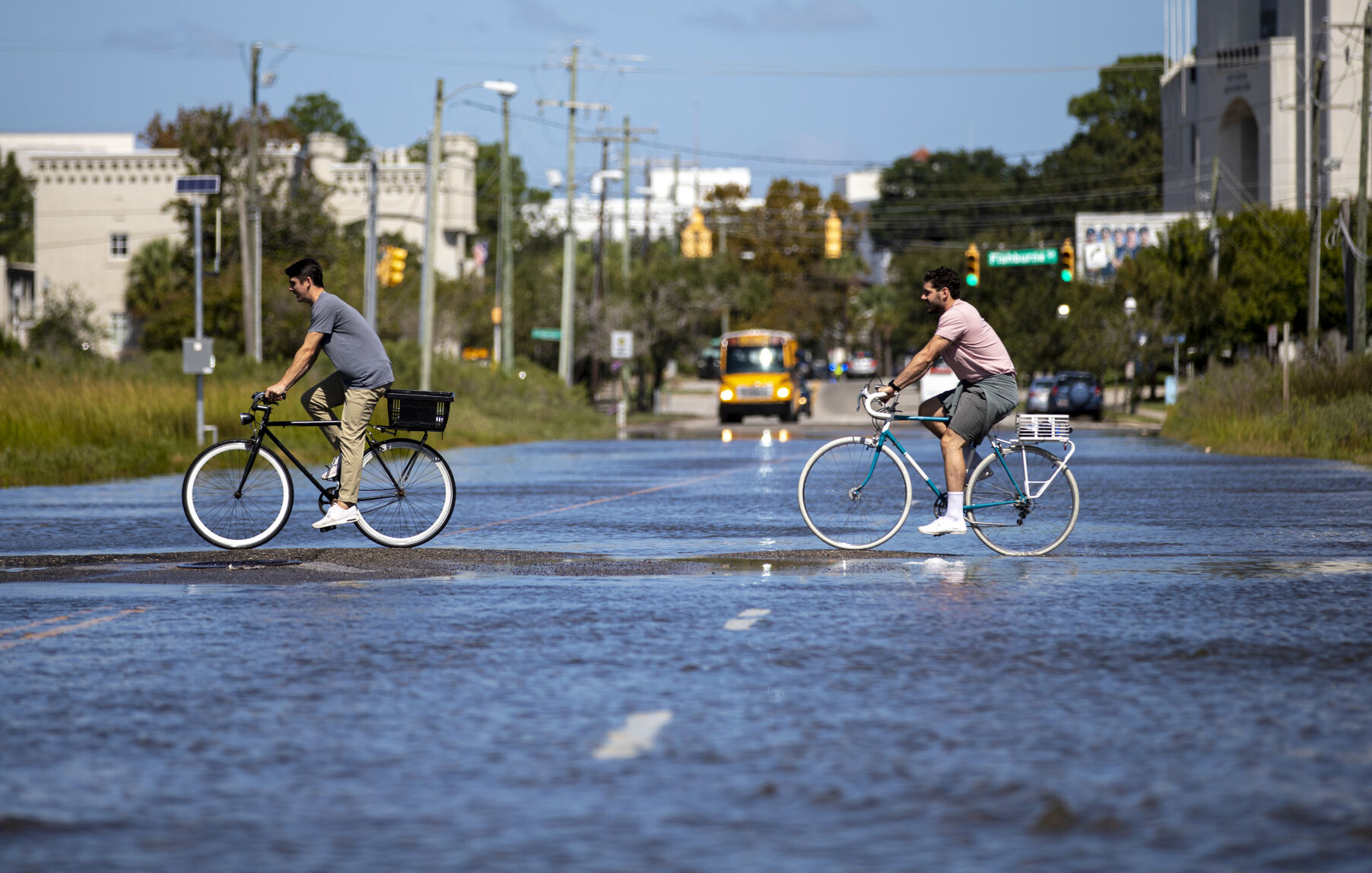
Charleston-area floodwaters are a festering soup of disease-carrying microbes, a new Post and Courier analysis shows.
Last week had Exhibits A and B: Under sunny skies, tidal floods sent salt water into low-lying areas of the city; then a few days later, the skies darkened, and a drenching storm suddenly converted streets into rivers.
During both events, a Post and Courier team of reporters collected water samples and delivered them to a state-certified lab.
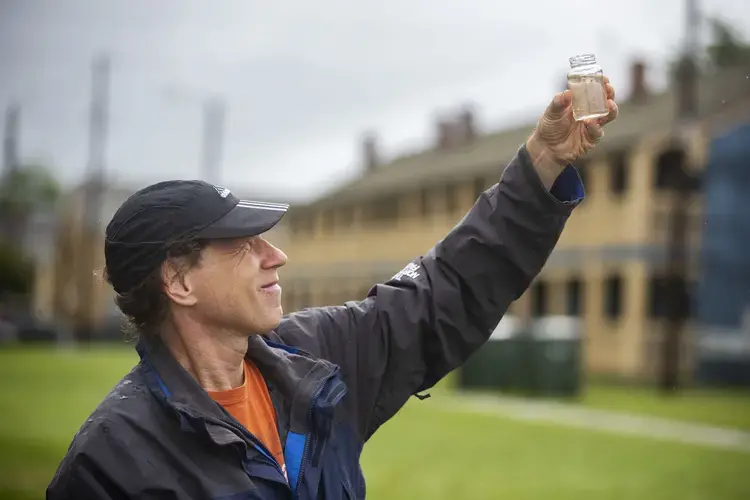
Results showed sky-high levels of E. coli bacteria near schools, public housing complexes and hospitals — in some places more than 60 times higher than state limits. Water samples in West Ashley, North Charleston and Mount Pleasant also were tainted.
Levels were so high that if health officials found them in recreational lakes, they’d have to close them.
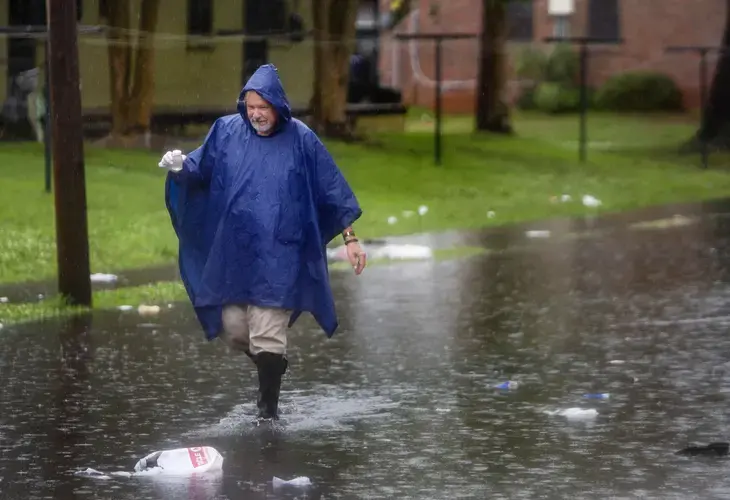
Taken together, last week’s tests and earlier sampling efforts for the newspaper’s Rising Waters project offer sobering and disgusting reminders: The region’s floods carry hidden health and safety risks; and because of a rapidly warming planet, these risks will increase.
“The message is clear: More intense rainstorms and more frequent floods aren’t just threatening our businesses, homes and commutes,” said Andrew Wunderley, head of Charleston Waterkeeper, a group that monitors area creeks and rivers. “They are threatening our health, too.”
Stomach turner
E. coli is short for Escherichia coli, a pathogen found in the feces of humans and animals. E. coli can make you sick to your stomach, cause diarrhea, generate rashes and infections and, in rare cases, harm your kidneys. Scientists also consider it an “indicator” that suggests even more harmful bacteria and viruses are present, including Hepatitis A.
Dr. Valerie Scott, a family care physician with Roper St. Francis Physician Partners, said floodwaters are nasty business for all, but these germ soups can present potentially life-threatening issues for young children and the elderly.
“When I see people walking through standing floodwater downtown, I just shut my eyes,” she said. “I can’t stand it. It’s horrible. There’s just too much going on in there. … If it’s not running water, just stay out of it.”
Scientists and public health officials measure bacteria levels by estimating the number of cell colonies in 100 milliliters of water, about half a cup. When it comes to drinking water, you’re not supposed to have any E. coli, because all it takes is one colony to make you ill. Standards for lakes and other bodies of water are higher.
If the state Department of Health and Environmental Control finds a swimming area with more than 349 colonies, the agency can close it.
During our tidal floods and rain bombs, low and poorly draining areas become temporary lakes and rivers. Some of this standing water can last for days, creating a petri dish of bacteria. Neither DHEC nor the city tests these waters. Instead, officials merely caution people to stay out of waters as best they can.
That’s not possible for people who need to get to work or school — or find themselves trapped in their cars by rising waters, as happened in several places during last week’s storm.
To better understand what’s in our murky floods, Post and Courier reporters fanned out to frequently flooded areas last week and during two previous floods.
Donning hip waders and sterile gloves, they collected samples in small plastic bottles and packed them into ice chests. With water still in the streets, they drove samples to Trident Labs Services, a state-certified lab in Ladson that works with industrial clients. Thirty-nine samples were analyzed. The results were revealing.
A sunny flood
Just after noon on Sept. 21, an 8-foot tide poured into the Lowcountry.
The sea level is about a foot higher today than it was a century ago, in large part because of global warming. And nuisance tides such as this used to happen just a few times a year. But this tide would mark the 43rd time in 2020 that water levels exceeded 7 feet, the height when flooding begins.
As the tide rose, a reporter went to Lockwood Boulevard, where the Ashley River had merged with the western edge of peninsular Charleston. A sample there showed relatively clean water. That made sense because the sample location was so close to the river.
But just a few blocks away, at Barre and Wentworth streets, an officer manned a barricade as residents walked through floodwaters to their homes. A sample taken there showed they were trudging through water with E. coli levels 16 times what’s deemed safe. Farther inland, near Colonial Lake, another sample was six times the safe level. Even farther inland, by Cannon Park, a rapidly forming pool had E. coli levels four times the state limit. Cannon Park is a popular place to take your dog.
On North Hanover Street, the water by Shawn Parks’ home and his backyard was about eight times the state limit. He’s laid down rocks to elevate his driveway and keeps rubber boots in his car and home, but he can’t help but wonder what filth he’s tracking in.
“What in the world am I suppose to do?” he said, upon learning of the test results. “I don’t want that stuff coming into my home.”
Skies were nearly cloudless as other low-lying areas filled with salt water. Samples in the rapidly gentrifying neighborhoods off Morrison Drive also contained high levels, as did sample sites near Gadsden Green, a public housing project north of the medical district. That area routinely floods — and even has a street named Flood Street.
It was surprising to find high levels in a tidal flood, but results literally were off the charts when the skies opened last Friday.
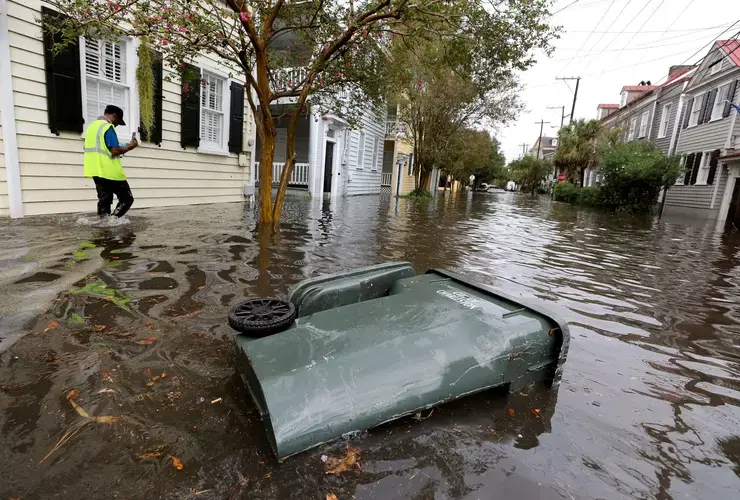
Dirty moats
It began to drizzle just before noon Friday, and then, gaining momentum, rain fell harder and harder.
Within a few minutes, water coursed through streets by Burke High School. It created whirlpools over grates until the city’s aging stormwater system was overwhelmed.
Then moats formed around the city’s medical district and Gadsden Green. Trucks plowed down Rutledge Avenue, creating wakes that washed like ocean waves against a school fence.
Colonies of bacteria grow quickly as floodwaters pick up waste from wildlife, pets and faulty sewer systems. Some of the worst readings were in the city’s densely populated neighborhoods.
This includes low-income areas such as Gadsden Green, where a sample at Line and Flood streets was seven times higher than the state limit. And a block from Burke High School, which was 50 times acceptable limits.
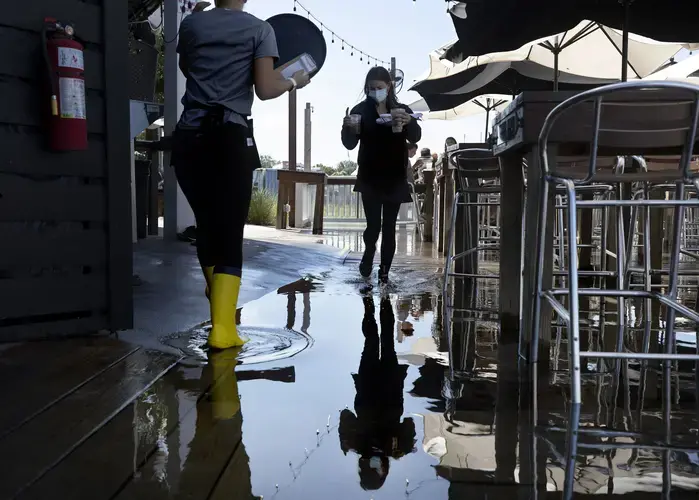
And, especially on Charleston’s East Side, which saw E. coli levels at least 69 times the limit at America and Amherst streets and America and Cooper streets. The actual readings may have been even higher: The number of cell colonies exceeded the testing limit of 24,200 colonies per sample.
“That is gross! Nasty!” a woman named Lexi said, wrinkling her nose when told about a sample taken at America and Harris streets, just yards from the stoop she sat on. A sample taken between Sanders-Clyde Elementary School and a densely packed housing project was 44 times the acceptable limit.
Lexi, who wouldn’t give her last name, said the area routinely floods during high tides and heavy rains, toppling garbage cans and sending trash floating through the streets where children walk to and from school. The foul water laps into apartments as well, she said, breeding mold that sickens area children. “It’s soooo bad,” she said.
Just up the street, 61-year-old Henry Sumter said he’s long known to keep his body out of the murky water that swallows his streets. “It makes you all itchy,” he said this week.
A few blocks over, an ice cream truck rolled through the intersection of America and Cooper streets, its speakers playing a circular children’s tune as its tires crunched over brown magnolia leaves, brittle twigs and other debris left behind from last week’s flooding.
This dry, sunny day seemed a world away from the previous Friday, when rising brown water swallowed a Nissan sedan and left the intersection all but impassable. College student Ethan Thorpe watched that water pour into his garage and fill up his neighbor’s yard. He figured he was safe with his waterproof shoes, but he wasn’t so sure after hearing how much E. coli was floating about. “That really makes me question it, and whatever else is in the water in general,” he said.
But high readings aren’t limited to downtown’s densely populated neighborhoods. They’re also found in suburban areas.
Off Pepperdam Lane, downstream of a rapidly developing area off Palmetto Commerce Parkway in North Charleston, a sample was nine times the state limit.
West of the Ashley, a reading on Wappoo Road not far from the West Ashley Greenway, was 28 times safe limits. Nearby, at Beverly Road and Chadwick Drive, a sample was 38 times the limit.
And, in Mount Pleasant, a sample in a parking lot at Shem Creek had E. coli levels four times the state maximum.

Yuck
“You have some really, really high results, yuck,” said Wunderley, the Charleston Waterkeeper. The group regularly tests the area’s waterways.
Like Dr. Scott, he said he also cringes when he sees social media posts of people swimming or playing in floodwaters. “If you cannot avoid getting wet, you should clean up with soap and water as soon as possible and avoid getting any water in (your) ears, eyes, nose, or mouth.” Polluted floodwater can be a health risk for pets, too, so it’s good idea to keep them out of the water, he said.
Matthew Fountain, the city of Charleston’s director of stormwater management, said bacteria levels can vary widely, even in small areas of flooding, but its presence at all is of concern to officials. The city has embarked on a number of projects to reduce the severity, frequency and duration of flooding, from the construction of a massive drainage tunnel on Charleston west side to the preventive cleaning of pipes and the installation of check valves to impede tidal inundations, he said.
“There is no one clear solution,” he said. “It’s sort of a basket of solutions. And one thing is awareness, making sure people know the risk of floodwater and not to play in it, not treat it like a recreational possibility.”
Despite the city’s efforts, these floods are likely to be even more common. Sea rise is accelerating because of global warming. Until the past few decades, the sea level rose at a manageable 1.4 inches every 10 years. Now it’s rising at a rate of nearly 3 inches a decade. At this pace, seas will be another foot higher in Charleston in 30 years.
For now, it’s common after storms to see people floating and frolicking in the standing waters, most not realizing that dog poop, bird excrement and other filthy treats have likely washed into the mix. Just last week, a video making the rounds on Twitter showed a Jeep towing a young man on a surfboard down a flooded street — until he lost control and plunged beneath the germ-laden wake.
Joe Watson can recall neighborhood children playing for days in the waters left on America Street by Hurricane Gracie in September 1959. No one would think to do that now, with all the unknowns in the cloudy floodwaters that bubble up from the sewers and fill the street near his community store, Mary’s Sweet Shop. And it’s happening more and more each year, he said.
Watson thinks it’s high time the city, its residents and whatever experts they can muster get together and find a way to address this looming threat from sea rise and climate change. It’s just not safe to go on the way we have been, he said.
“We all need to be talking to each other more,” he said. “We all need to be worrying about this, and what our children — our people — are going to be living with in the future.”



